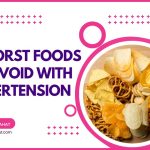10 Causes of Feeling Like Food Stuck in Chest After Eating.
Our content is not intended nor recommended as a substitute for medical advice by your doctor. Use for informational purposes only.
What you need to Know:
The feeling of food stuck in your chest after eating is often a symptom of esophageal dysphagia.
Dysphagia is a medical term that refers to (difficulty swallowing) which causes the sensation of food stuck inside your chest.
Three main mechanisms lead to such symptoms:
- Mechanical obstruction of the esophagus is either due to intrinsic esophageal disease or compression from outside the esophagus.
- Motility disorder (Abnormal movement) of the esophagus: The most common type of motility disorder is achalasia (see later).
- Functional dysphagia.
The feeling of food stuck in the chest after eating can be due to simple causes such as bad eating habits (eating too fast or swallowing a large amount of food at once). However, they can also be due to GERD, hiatal hernia, achalasia, etc.
When to worry:
If dysphagia occurs occasionally or infrequently, you don’t have to worry or expect a bad scenario. However, many people occasionally experience this feeling due to simple causes such as fast or faulty eating.
However, if the condition is severe, frequent, persistent, or lasting for several hours, you should see a doctor.
Warning signs include vomiting of undigested food, severe anorexia, weight loss, foul mouth odor, and black stool.
1. GERD and hiatal hernia.
GERD (gastroesophageal reflux disease) is caused by frequent regurgitation of stomach acid into the esophagus. Your stomach can protect itself from the acid, while the esophagus cannot.
GERD (also called chronic acid reflux) is a prevalent condition. It can be due to malfunction of the lower esophageal sphincter (the sphincter between the esophagus and the stomach) or hiatal hernia.
Hiatal hernia (one of the causes of acid reflux) occurs when a part of your stomach herniates into your chest through the diaphragm.
Both GERD and hiatal hernia can cause the feeling of food stuck in the chest after eating.
Symptoms of GERD and Hiatal Hernia:
- Heartburn (the main symptom): Normal people can experience intermittent heartburn attacks (Physiological GERD). But if GERD is present and undiagnosed, it can cause persistent heartburn.
- Regurgitation of acidic fluid or food particles into your throat or mouth.
- Night attacks of severe heartburn and choking due to acid reflux during lying down.
- Difficulty swallowing (dysphagia) and feeling like food is stuck in the chest after eating. This is especially common with complications and hiatal hernia.
- Chest pain that can mimic a heart attack
- Increased salivation
- Nausea and vomiting.
The most common symptoms of GERD are heartburn and regurgitation of food or acidic fluid into the throat.
The presence of dysphagia (the feeling like food is stuck in the chest or difficulty swallowing) with GERD is an alarm sign. Dysphagia with GERD may indicate complications (stricture, Barret’s esophagus, and esophageal cancer).
2. Functional Dysphagia.
Functional dysphagia is a term that refers to the sensation of difficulty swallowing or food stuck in the chest after eating without apparent cause.
The diagnosis of functional dysphagia requires the exclusion of all other causes of dysphagia, such as GERD, achalasia, motility disorders, and esophageal tumors.
The cause of functional dysphagia is unclear. However, it relates to other functional gut diseases and may be related to psychological stress or stress (gut-brain axis dysfunction) (reference).
The symptoms of functional dysphagia are often intermittent (comes and goes) for several months, with no symptoms suggestive of other diseases.
3. Achalasia.
Achalasia is an esophageal motility disorder of unknown cause. As a result, the lower part of the esophagus loses its motility, and the lower esophageal sphincter (LES) fails to relax.
The failure of LES relaxation causes fluid to get stuck in your chest (inside the esophagus) after eating.
It is an uncommon disease that can occur at any age. However, achalasia is commonly diagnosed in patients between 25 and 60 years (reference).
Symptoms:
- Progressive difficulty in swallowing (dysphagia) that increases over time.
- A feeling like food stuck in the chest after eating.
- The swallowing difficulty is often for both solids (91%) and liquids (85%).
- Regurgitation of bland undigested food after eating.
- Chest pain after eating.
- Heartburn.
- Bleching.
The difficulty in swallowing is very significant and often progressive. Therefore, achalasia is diagnosed by barium esophagogram (X-ray after swallowing a dye), endoscopy, and esophageal manometry (measuring the tone of the LES).
4. Benign and malignant esophageal tumors.
Esophageal tumors, including benign and malignant cancers, are uncommon (reference).
They affect men more than women. For example, esophageal tumors can cause mechanical obstruction of the esophagus leading to the feeling of stuck foods in the chest after eating.
Symptoms:
- Trouble swallowing (feeling like food suck in the chest after eating). The symptom is often progressive over time.
- Chest pain.
- Weight loss.
- Vomiting after eating.
- Regurgitation of undigested food.
- Bleeding into the esophagus. This leads to either vomiting blood or passage of black stool (melena).
- Anorexia (loss of appetite).
- Badmouth odor.
- Hoarseness and chronic cough.
5. Esophageal Stricture.
An esophageal stricture is an abnormal area of tightening or narrowing of the esophagus. After eating, this narrow area makes food stuck in the esophagus (in the chest).
Esophageal strictures occur due to a variety of causes:
- GERD and Hiatal hernia.
- Esophageal cancer.
- Radiation to the esophagus.
- Chronic esophageal inflammation as with eosinophilic esophagitis.
- Previous esophageal surgery.
- Some medications and chemicals.
Symptoms:
- Difficulty swallowing (feeling like food is stuck in the chest after eating).
- Burning sensation in the chest, neck, or throat.
- Frequent episodes of choking.
- Regurgitation of undigested food into the mouth.
6. Esophageal Diverticulum.
Esophageal diverticula are sac-like protrusion of the protrusions wall through a weak division. It commonly affects the upper part of the esophagus.
They are caused by a weakness (congenital or due to a disease) in the esophageal muscular wall.
They can affect any part of the esophagus:
- In the upper part of the esophagus (commonest): the sac protrudes into the back of the throat (Zenker’s diverticulum).
- In the middle part of the esophagus (in the mid-chest).
- In the lower part of the esophagus (Epiphrenic diverticulum), just above the diaphragm.
Symptoms include:
- Difficulty swallowing: depending on its side, the mid-chest and lower esophageal diverticulum cause the feeling of food stuck in the chest after eating.
- Zenker’s diverticulum causes choking aspiration of food into the trachea.
- Regurgitation of swallowed food and saliva.
- Pain during swallowing.
- Cough.
- Weight loss.
- Bad breath odor.
7. Esophageal inflammation (esophagitis).
Esophageal inflammation can impair motility, narrowing (strictures), and diverticula.
Esophagitis is common and occurs due to multiple causes, such as:
- Reflux esophagitis (commonest, explained before under GERD).
- Eosinophilic esophagitis (chronic immune-mediated inflammation of the esophagus).
- Pill esophagitis (some medicines may get stuck in the esophagus and cause severe local inflammation).
- Chemical esophagitis (ingesting very irritant chemical materials such as caustics).
- Infections such as monilial esophagitis (often affects patients with low immunity).
- Lymphocytic esophagitis (rare).
8. Other esophageal diseases.
Other less common esophageal diseases that can cause the feeling of food stuck in the chest after eating:
- Post-esophageal or diaphragmatic surgery.
- Post-hiatal hernia operation (excessive narrowing of the lower esophageal sphincter.
- Esophageal radiation.
- Other esophageal motility disorders such as diffuse esophageal spasm and corkscrew esophagus.
- Congenital esophageal rings and webs (symptoms often appear in early infancy, not during adulthood).
- Chagas disease.
- Scleroderma (systemic sclerosis).
9. Outside compression of the esophagus.
The esophagus passes through the chest and is surrounded by thoracic structures such as the heart, aorta, trachea, lungs, and lymph nodes.
Masses inside the chest can compress the esophagus and cause the feeling of food stuck in the chest after eating.
Common causes include:
- Abnormal location of an artery called (the subclavian artery) inside the chest.
- Abnormal bony prominences of the neck vertebrae (cervical osteophytes).
- Enlarged aorta inside the chest.
- Enlarged left atrium of the heart.
- Mass close to the esophagus, such as lung cancer, enlarged lymph nodes, etc.
- Evidence-based
- Written by a doctor.






